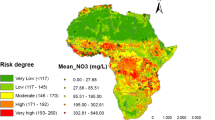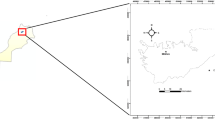Abstract
Many of Florida’s large springs have seen an order of magnitude increase in nitrate concentration since the mid-twentieth century, which has contributed to the proliferation of nuisance algae and alteration of spring ecosystems. Cost-effective strategies to limit nitrate inputs require identification of contributing land areas within springs (springsheds) where surficial nitrogen sources are most likely to be transported to the underlying aquifer. To address spatial variability in vulnerability to nitrogen loading, spatial models specific to nitrate were developed for the Silver Springs springshed (Florida, USA). Random forest classification models were trained using an extensive (1554 wells) groundwater nitrate dataset assembled from public water system and agency monitoring data. Spatial layers representing soil hydrology, subsurface geology, recharge potential, and nitrogen sources were used as predictor variables. Random forest models produced out-of-bag error estimates of 21% or less, and variable importance plots indicated that a subset of subsurface geological predictors was the most important contributors to overall model accuracy. Although predictors representing land use and nitrogen sources contributed less to overall model accuracy, they were still important in the final spatial discrimination of the most vulnerable areas. Random forest model accuracy was further improved by kriging of model residuals, and kriged residuals were added to model estimates to produce final prediction maps. The models developed are well suited for a management decision framework for environmental restoration, as it informs the manager with maps of probabilistic information. Recognizing the potential for legacy nitrate impacts, we recommend the current models be adopted as a part of a tiered approach to restoration projects that first prioritizes critical areas using the models presented herein and subsequently uses site-specific information to verify local impacts.






Similar content being viewed by others
References
Albertin AR, Sickman JO, Pinowska A, Stevenson RJ (2012) Identification of nitrogen sources and transformations within karst springs using isotope tracers of nitrogen. Biogeochemistry 108:219–232. https://doi.org/10.1007/s10533-011-9592-0
Aller L, Bennet T, Lehr JH, Petty RJ (1987) DRASTIC: a standardized system for evaluating ground water pollution using hydrological settings. US EPA document no. EPA/600/2-85-018
Almasri MN, Kaluarachchi JJ (2007) Modeling nitrate contamination of groundwater in agricultural watersheds. J. Hydrol 343:211–229. https://doi.org/10.1016/j.jhydrol.2007.06.016
Arthur J, Wood HA, Baker A, Cichon J, Raines G (2007) Development and implementation of a bayesian-based aquifer vulnerability assessment in Florida. Nat Resour Res 16:93–107. https://doi.org/10.1007/s11053-007-9038-5
Boniol D, Williams M, Munch D (1993) Mapping recharge to the Floridan aquifer using a geographic information system. Technical Publication SJ93-5. St Johns River Water Management District, Palatka
Boniol D, Davis J, Jeannee N, Stokes J (2014) Top of the Floridan aquifer system in peninsular Florida. Technical Fact Sheet SJ2014-FS1. St Johns River Water Management District, Palatka
Breiman L (2001) Random forests. Mach Learn 45:5–32
Budd DA, Vacher HL (2004) Matrix permeability of the confined Floridan aquifer, Florida, USA. Hydrogeol J 12:531–549. https://doi.org/10.1007/s10040-004-0341-5
Cohen MJ, Lamsal S, Korhnak LV (2007) Sources, transport and transformation of nitrate-n in the florida environment, special publication SJ2007-SP10. St. Johns River Water Management Disctrict, Palatka
Eller KT, Katz B (2014) Nitrogen source inventory and loading estimates for the Silver Springs BMAP contributing area (Final Draft). Florida Department of Environmental Protection, Tallahassee
FDOH (2016) Florida Water Management Inventory Project. Florida Department of Health. http://www.floridahealth.gov/environmental-health/onsite-sewage/research/flwmi/index.html. Accessed Dec 2016
Friedman J, Hastie T, Tibshirani R (2009) The elements of statistical learning : data mining, inference, and prediction, springer series in statistics. Springer, New York
Gurdak JJ, Qi SL (2012) Vulnerability of recently recharged groundwater in principle aquifers of the united states to nitrate contamination. Environ Sci Technol 46:6004–6012. https://doi.org/10.1021/es300688b
Heffernan JB, Albertin AR, Fork ML, Katz BG, Cohen MJ (2012) Denitrification and inference of nitrogen sources in the karstic Floridan Aquifer. Biogeosciences 9:1671–1690
Hengl T (2009) A practical guide to geostatistical mapping. http://spatial-analyst.net/book/. Accessed June 2016 (self published online book ISBN: 978-90-9024981-0)
Katz BG (2004) Source of nitrate contamination and age of water in large karstic springs of Florida. Environ Geol 46:689–706
Katz BG, Sepulveda AA, Verdi RJ (2009) Estimating nitrogen loading to ground water and assessing vulnerability to nitrate contamination in a large karstic springs basin, Florida. J Am Water Resour Assoc 45:607–627
Kuhn M (2008) Building predictive models in R using the caret package. J Stat Softw 28:1–26
Kuniansky EL, Bellino JC, Dixon JF (2012) Transmissivity of the upper Floridan aquifer in Florida and parts of Georgia, South Carolina, and Alabama, U.S. Geological Survey Scientific Investigations Map 3204. https://pubs.usgs.gov/sim/3204. Accessed July 2018
Liaw A, Wiener M (2002) Classification and regression by randomForest. R News 2:18–22
Lindsey B, Katz B, Berndt M, Ardis A, Skach K (2010) Relations between sinkhole density and anthropogenic contaminants in selected carbonate aquifers in the eastern United States. Environ Earth Sci 60:1073–1090. https://doi.org/10.1007/s12665-009-0252-9
MACTEC Engineering and Consulting Inc (2007) Phase I report Wekiva River basin nitrate sourcing study. Prepared for the St. Johns River Water Management District (Palatka, FL) and the Florida Department of Environmental Protection (Tallahassee, FL)
Munch Toth, Huang Davis, Fortich Osburn, Phlips Quinlan, Allen Woods, Cooney Knight, Clarke Knight (2007) Fifty-year retrospective study of the ecology of Silver Springs, Florida, Special Publication SJ2007-SP4. St. Johns River Water Managmeent District, Palatka
National Climatic Data Center (2018) NOAA. https://www.ncdc.noaa.gov/. Accessed Aug 2018
Nolan BT, Hitt KJ, Ruddy BC (2002) Probability of nitrate contamination of recently recharged groundwaters in the conterminous United States. Environ Sci Technol 36:2138–2145. https://doi.org/10.1021/es0113854
NRCS (2016) Soil Survey Staff, Natural Resources Conservation Service, United States Department of Agriculture. Soil Survey Geographic (SSURGO) Database for Florida. https://websoilsurvey.sc.egov.usda.gov/App/HomePage.html. Accessed June 2016
Pacheco FAL, Van Der Weijden CH (2002) Mineral weathering rates calculated from spring water data: a case study in an area with intensive agriculture, the Morais Massif, northeast Portugal. Appl Geochem 17:583–603. https://doi.org/10.1016/S0883-2927(01)00121-4
Pacheco FAL, Sousa Oliveira A, Van Der Weijden AJ, Van Der Weijden CH (1999) Weathering, biomass production and groundwater chemistry in an area of dominant anthropogenic influence, the Chaves-Vila Pouca de Aguiar region, north of Portugal. Water Air Soil Pollut 115:481–512. https://doi.org/10.1023/A:1005119121666
Pacheco FAL, Martins LMO, Quininha M, Oliveira AS, Sanches Fernandes LF (2018) Modification to the DRASTIC framework to assess groundwater contaminant risk in rural mountainous catchments. J Hydrol 566:175–191. https://doi.org/10.1016/j.jhydrol.2018.09.013
Pebesma EJ (2004) Multivariable geostatistics in S: the gstat package. Comput Geosci 30:683–691
Pebesma EJ, Bivand RS (2005) Classes and methods for spatial data in R. R News 5:9–13
Phelps GG (2004) Chemistry of ground water in the silver springs basin, Florida, with an emphasis on nitrate. Scientific Investigations Report 2004-5144. U.S. Geological Survey, Reston
Price CV, Nakagaki N, Hitt KJ, Clawges RM (1990) Enhanced historical land-use and land-cover data sets of the U.S.Geological Survey. Data Series 240. U.S. Geological Survey, Reston. https://water.usgs.gov/GIS/dsdl/ds240/index.html. Accessed June 2016
Quinlan EL, Phlips EJ, Donnelly KA, Jett CH, Sleszynski P, Keller S (2008) Primary producers and nutrient loading in Silver Springs, FL, USA. Aquat Bot 88:247–255
R Core Team (2017) R: a language and environment for statistical computing. R Foundation for Statistical Computing, Vienna, Austria
Reddy KR, Dobberfuhl D, Fitzgerald CMC, Frazer T, Graham W, Jawitz J, Kaplan D, Inglett P, Martin J, Osborne T, Burger P, Canion A, Coveney M, Lowe E, Mattson R, Slater J, Sucsy P (2017) Collaborative research initiative on springs protection and sustainability (CRISPS): final report. St Johns River Water Management District, Palatka
Rodriguez-Galiano V, Mendes MP, Garcia-Soldado MJ, Chica-Olmo M, Ribeiro L (2014) Predictive modeling of groundwater nitrate pollution using Random Forest and multisource variables related to intrinsic and specific vulnerability: a case study in an agricultural setting (Southern Spain). Sci Total Environ 476–477:189–206. https://doi.org/10.1016/j.scitotenv.2014.01.001
Sing T, Sander O, Beerenwinkel N, Lengauer T (2005) ROCR: visualizing classifier performance in R. Bioinformatics 21:7881
SJRWMD (2011) 2009 Land cover and land use. St. Johns River Water Management District, Palatka
Stevenson RJ, Pinowska A, Albertin A, Sickman JO (2007) Ecological condition of algae and nutrients in Florida springs: the synthesis report. Prep. Florida Dep. Environ. Prot, Tallahassee
Stokes J, Huang C (2013) Silver springs refinement (GIS layer). St Johns River Water Managment District, Palatka
Tesoriero AJ, Voss FD (1997) Predicting the probability of elevated nitrate concentrations in the Puget Sound Basin: implications for aquifer susceptibility and vulnerability. Groundwater 35:1029–1039
Williams LJ, Dixon JF (2015) Digital surfaces and thicknesses of selected hydrogeologic units of the Floridan aquifer system in Florida and parts of Georgia, Alabama, and South Carolina. United States Geol. Surv. DS 926
Wynn S, Borisova T, Hodges A (2014) Economic value of the services provided by florida springs and other water bodies : a summary of existing studies. Univ. Florida IFAS FE959, pp 1–8
Acknowledgements
The authors would like to acknowledge Shane Williams, Mary Paulic, Jeff Davis, Brandon Dees, and Bill VanSickle for providing valuable feedback, datasets, and GIS assistance to support this work.
Author information
Authors and Affiliations
Corresponding author
Additional information
Publisher's Note
Springer Nature remains neutral with regard to jurisdictional claims in published maps and institutional affiliations.
Electronic supplementary material
Below is the link to the electronic supplementary material.
Rights and permissions
About this article
Cite this article
Canion, A., McCloud, L. & Dobberfuhl, D. Predictive modeling of elevated groundwater nitrate in a karstic spring-contributing area using random forests and regression-kriging. Environ Earth Sci 78, 271 (2019). https://doi.org/10.1007/s12665-019-8277-1
Received:
Accepted:
Published:
DOI: https://doi.org/10.1007/s12665-019-8277-1




